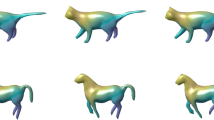Abstract
Shape features are becoming increasingly important for inferences in image analysis. Shape analysis involves choosing mathematical representations of shapes, deriving tools for quantifying shape differences, and characterizing imaged objects according to the shapes of their boundaries. In this paper, we focus on characterizing shapes of continuous curves, both open and closed, in ℝ2. Under appropriate constraints that remove shape-preserving transformations, these curves form infinite-dimensional, non-linear spaces, called shape spaces, on which inferences are posed. We impose two Riemannian metrics on these spaces and study properties of the resulting structures. An important tool in Riemannian analysis of shapes is the construction of geodesic paths in shape spaces. Not only do the geodesics quantify shape differences, but they also provide a framework for computing intrinsic shape statistics. We will present algorithms to compute simple shape statistics — means and covariances — and will derive probability models on shape spaces using local principal component analysis (PCA), called tangent PCA (TPCA). These concepts are demonstrated using a number of applications: (i) unsupervised clustering of imaged objects according to their shapes, (ii) developing statistical shape models of human silhouettes in infrared surveillance images, (iii) interpolation of endo-and epicardial boundaries in echocardiographic image sequences, and (iv) using shape statistics to test phylogenetic hypotheses.
Access this chapter
Tax calculation will be finalised at checkout
Purchases are for personal use only
Preview
Unable to display preview. Download preview PDF.
Similar content being viewed by others
References
Y. Chen, H. Tagare, S. Thiruvenkadam, F. Huang, D. Wilson, K. Gopinath, R.W. Briggs, and M.A. Geiser. Using prior shapes in geometric active con-tours in a variational framework. International Journal of Computer Vision, 50(3):315–328, 2002.
Y. Chen, S. Thiruvenkadam, H. Tagare, F. Huang, D. Wilson, and A. Geiser. On the incorporation of shape priors into geometric active contours. In Proceedings of IEEE Workshop in Variational and Level Set Methods in Computer Vision, pages 145–152, 2001.
T.F. Cootes, C.J. Taylor, D.H. Cooper, and J. Graham. Active shape models: Their training and application. Computer Vision and Image Understanding, 61(1):38–59, 1995.
I.L. Dryden and K.V. Mardia. Statistical Shape Analysis. John Wiley & Sons, 1998.
U. Grenander. General Pattern Theory. Oxford University Press, 1993.
U. Grenander and M.I. Miller. Computational anatomy: An emerging disci-pline. Quarterly of Applied Mathematics, LVI(4):617–694, 1998.
T. Hofmann and J.M. Buhmann. Pairwise data clustering by deterministic annealing. IEEE Transactions on Pattern Analysis and Machine Intelligence, 19(1):1–14, 1997.
A.K. Jain and R.C. Dubes. Algorithms for Clustering Data. Prentice-Hall, 1988.
H. Karcher. Riemann center of mass and mollifier smoothing. Communications on Pure and Applied Mathematics, 30:509–541, 1977.
E. Klassen, A. Srivastava, W. Mio, and S. Joshi. Analysis of planar shapes using geodesic paths on shape spaces. IEEE Pattern Analysis and Machine Intelligence, 26(3):372–383, March 2004.
H.L. Le and D.G. Kendall. The Riemannian structure of Euclidean shape spaces: a novel environment for statistics. Annals of Statistics, 21(3):1225–1271, 1993.
W. Mio and A. Srivastava. Elastic string models for representation and analysis of planar shapes. In Proc. of IEEE Computer Vision and Pattern Recognition, 2004.
C.G. Small. The Statistical Theory of Shape. Springer, 1996.
A. Srivastava, S. Joshi, W. Mio, and X. Liu. Statistical shape analysis: Cluster-ing, learning and testing. IEEE Transactions on Pattern Analysis and Machine Intelligence, 27(4):590–602, 2005.
D.C. Wilson, M.E.A. Geiser, and J.J. Larocca. Automated analysis of echocardiographic apical 4-chamber images. In Proceedings of the International Society for Optical Engineering in Mathematical Modeling, Estimation, and Imaging, volume 4121, pages 128–139, 2000.
D. Swiderski, M. Zelditch, and W. Fink. Phylogenetic analysis of skull shape evolution in marmotine squirrels using landmarks and thin-plate splines. In Italian Journal of Mammalogy (Hystrix), Special Issue, 10(2):115–130, 2000.
J. Felsenstein. Phylogenies and the comparative method. In American Natu-ralist, 125:1–15. 1985.
M. Vaillant, M.I. Miller, L. Younes, and A. Trouve. Statistics on diffeomor-phisms via tangent space representations. NeuroImage, Elsevier. S161–S169. 2005.
M.I. Miller and L. Younes. Group actions, homeomorphisms, and matching: A general framework. International Journal of Computer Vision, 41(1/2):61–84, 2001.
L. Younes. Computable elastic distance between shapes. SIAM Journal of Applied Mathematics, 58(2):565–586, 1998.
S. Helgason. Differential Geometry, Lie Groups and Symmetric Spaces. Academic Press, 1978.
Author information
Authors and Affiliations
Editor information
Editors and Affiliations
Rights and permissions
Copyright information
© 2006 Birkhäuser Boston
About this chapter
Cite this chapter
Joshi, S., Kaziska, D., Srivastava, A., Mio, W. (2006). Riemannian Structures on Shape Spaces: A Framework for Statistical Inferences. In: Krim, H., Yezzi, A. (eds) Statistics and Analysis of Shapes. Modeling and Simulation in Science, Engineering and Technology. Birkhäuser Boston. https://doi.org/10.1007/0-8176-4481-4_13
Download citation
DOI: https://doi.org/10.1007/0-8176-4481-4_13
Publisher Name: Birkhäuser Boston
Print ISBN: 978-0-8176-4376-8
Online ISBN: 978-0-8176-4481-9
eBook Packages: Mathematics and StatisticsMathematics and Statistics (R0)




